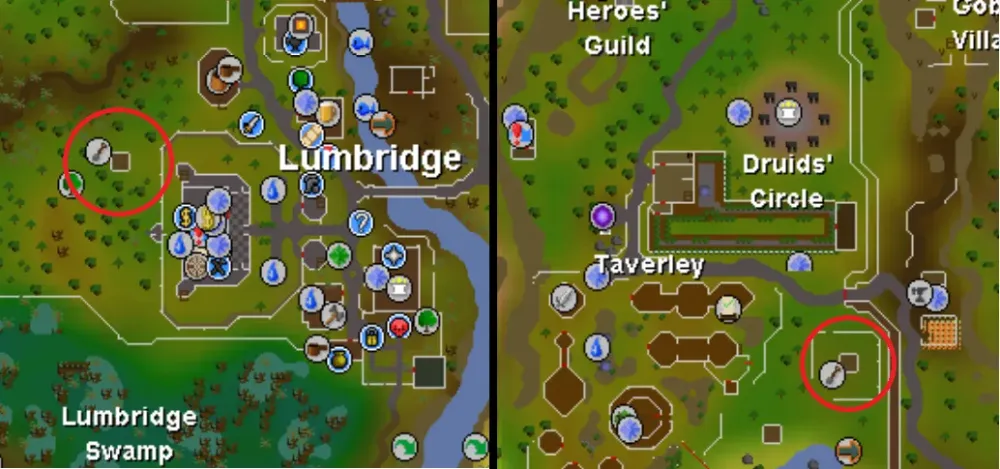Your cart is empty
Ultimate Guide to Farming Patch Locations in OSRS

Farming in Old School RuneScape (OSRS) is a crucial skill that allows players to grow their own crops, herbs, and trees, providing essential resources for various gameplay aspects. Mastering this skill not only enhances your gameplay experience but also offers a steady income through the sale of harvested items. This guide will explore the various farming patches available in OSRS, helping you identify the best locations for efficient and profitable farming.
Farming patches in OSRS are designated areas where players can plant seeds and grow crops, herbs, and trees. Each type of patch has specific characteristics, requirements, and crop options. Understanding the different patches is essential for maximizing your farming efficiency.
There are several types of farming patches, including:
- Flower Patches: Used for planting flowers. These patches can be found in locations like Varrock and Falador.
- Herb Patches: Ideal for growing herbs; they provide a good source of potions. Herb patches are located in places such as Taverley and Catherby.
- Tree Patches: Designed for growing trees, which yield logs and fruit. Notable locations include Gnome Stronghold and the Tree Gnome Village.
- Fruit Tree Patches: These patches allow players to grow fruit trees that provide fruit and wood. They can be found in places such as Gielinor and the Taverley area.
- Allotment Patches: Used for growing vegetables and other crops, allotment patches are located in several towns, including Lumbridge and Ardougne.
Each patch has unique features, such as the ability to use compost or plant specific crops. Many patches are also associated with quests or require certain levels to access. For instance, the highest-tier patches often yield better crops but require higher Farming levels and specific items to plant.
Additionally, players can enhance their farming efficiency by utilizing tools such as the Farming cape, which provides various benefits, including teleportation to farming patches. It’s also essential to consider the growth times for different plants, as some crops mature faster than others, allowing for more frequent harvesting.
Understanding the layout and characteristics of each farming patch will help you plan your farming activities effectively, ensuring you maximize your yield and profit from your agricultural endeavors in OSRS.
3. List of Farming Patch Locations
When it comes to farming in Old School RuneScape (OSRS), knowing the locations of farming patches is crucial for maximizing your efficiency and yield. Here’s a handy list of the primary farming patch locations:
- Varrock:
- Falador:
- Ardougne:
- Catherby:
- Catherby Patch
- Taverley:
- Taverley Patch
- Hosidius:
- Hosidius Patch
- Giant’s Foundry:
- Giant’s Foundry Patch
- Tree Patches:
- Located in various areas, including Varrock, Falador, and Taverley.
Each of these locations has its unique advantages, so be sure to plan your farming routes accordingly!
4. Best Practices for Using Farming Patches
Using farming patches effectively can greatly enhance your crop yields and overall efficiency. Here are some best practices to consider:
- Always Use Compost: Using regular or super compost can significantly increase the yield of your crops. It’s a simple step that pays off!
- Plan Your Crops: Always plan what you want to grow. Some crops take longer than others, so align your farming schedule with your activities.
- Utilize Farming Contracts: Engaging in farming contracts can help you gain additional rewards and experience. It’s a win-win!
- Check the Weather: For certain crops, weather conditions can affect growth. Keep an eye on in-game weather patterns when planning your crops.
- Use Teleports: Make use of teleportation methods to quickly reach farming patches. Items like the Amulet of Glory or the Fairy Ring can save you a lot of time.
- Pay Attention to Weeds: Regularly check your patches for weeds. Weeds can hinder growth and reduce your yield.
By following these best practices, you’ll not only improve your farming skills but also enjoy the process even more!
5. Farming Patch Accessibility by Region
Understanding the accessibility of farming patches in Old School RuneScape (OSRS) can significantly enhance your farming experience. Each region offers unique patches, and knowing where they are can save you time and effort. Here’s a breakdown of farming patch accessibility by region:
- Lumbridge & Draynor
- Draynor Village: The patch is located south of the bank, making it super convenient for quick visits.
- Lumbridge: There’s a patch just behind the Lumbridge Castle.
- Varrock
- Falador
- South Falador: A patch right next to the south gate allows for quick farming runs.
- West Falador: Located near the crafting guild, it’s also a popular spot.
- Taverley
- Ardougne
In summary, being aware of where your farming patches are located can optimize your farming runs. Each region has its perks, so choose the patches that work best for your farming goals!
6. Tips for Efficient Farming
Farming in OSRS can be a rewarding yet time-consuming task if not done efficiently. Here are some practical tips to help you maximize your farming efforts:
- Plan Your Routes: Map out your farming routes to minimize travel time. Group patches that are close to each other to save on running.
- Use Teleports Wisely: Utilize teleport spells or items to reach patches quickly. For example, the Amulet of Glory is perfect for quick access to Draynor.
- Check the Farming Guild: Once unlocked, the Farming Guild offers several patches and a convenient bank, making it a hub for farming activities.
- Manage Your Time: Use a timer to remind you when your crops are ready to be harvested. This way, you won’t waste any time waiting around.
- Use Super Compost: Applying super compost to your patches increases your yield and reduces the chance of disease.
- Be Mindful of Weeds: Regularly check your patches for weeds and clear them to keep your crops healthy.
- Utilize Farming Contracts: These contracts can help you level up your farming while providing useful rewards.
By implementing these tips, you’ll find that your farming runs become more productive and enjoyable. Happy farming!
Common Mistakes to Avoid
When it comes to farming patches in Old School RuneScape (OSRS), avoiding common pitfalls can save you time and resources. Here’s a list of frequent mistakes players make, along with tips to help you steer clear of them:
- Neglecting Patch Maintenance: One of the biggest mistakes is failing to check your patches regularly. Crops can die if left unattended too long, costing you both time and money.
- Choosing the Wrong Crops: Not all crops are created equal! Some may yield better profit margins than others, so always research what’s currently in demand.
- Ignoring Weeding: Weeds can choke your crops and hinder growth. Always remember to weed your patches when needed to ensure a healthy harvest.
- Overlooking Disease Control: Crops can become diseased, which can be detrimental to your farming efforts. Use plant cures promptly to prevent crop loss.
- Skipping the Use of Farming Tools: Make use of farming tools like the spade and supercompost. They can increase your yields and help in maintaining your patches more effectively.
- Not Using the Right Farming Level: Attempting to farm crops that are too high for your current farming level can lead to disaster. Always match your farming level with the crops you intend to plant.
Avoiding these common mistakes will not only enhance your farming experience but will also maximize your efficiency and profits in OSRS.
Conclusion and Final Thoughts
Farming in OSRS is a rewarding experience, but it does come with its challenges. By familiarizing yourself with the various farming patch locations and the crops you can grow, you can significantly optimize your farming activities.
Remember, the key to successful farming lies in:
- Planning: Always have a strategy in place before you start planting.
- Consistency: Regular maintenance is crucial for successful crop yields.
- Adaptability: Stay updated with game changes and market trends to adjust your farming practices accordingly.
In conclusion, whether you’re a seasoned farmer or just starting out, mastering these techniques will enhance your gameplay. Keep experimenting with different crops and patches, and don’t forget to enjoy the process! Good luck, and may your farming adventures in OSRS be fruitful!
